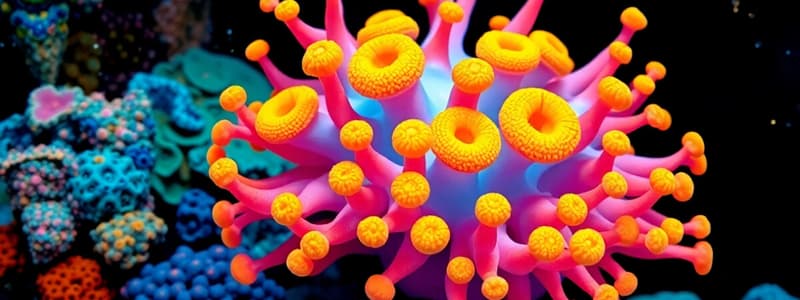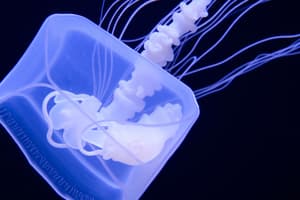Podcast
Questions and Answers
Which characteristic primarily distinguishes Hydrozoa from other cnidarian classes?
Which characteristic primarily distinguishes Hydrozoa from other cnidarian classes?
- Box-shaped medusa morphology.
- Nematocyst-bearing tentacles.
- Gonads derived from epidermal tissue. (correct)
- Highly potent venom.
All Hydrozoa species exhibit both polypoid and medusoid forms in their life cycle.
All Hydrozoa species exhibit both polypoid and medusoid forms in their life cycle.
False (B)
What is the general shape of Cubozoa medusa?
What is the general shape of Cubozoa medusa?
box-shaped
The central gastrovascular cavity of a polyp is lined by the ______.
The central gastrovascular cavity of a polyp is lined by the ______.
Match the cnidarian class with its characteristic:
Match the cnidarian class with its characteristic:
Jellies with a box-shaped medusa are from class ______.
Jellies with a box-shaped medusa are from class ______.
What size does the cubozoans typically achieve?
What size does the cubozoans typically achieve?
Cubozoans display overall morphological and anatomical characteristics that are similar to those of the scyphozoans.
Cubozoans display overall morphological and anatomical characteristics that are similar to those of the scyphozoans.
What is a prominent difference between cubozoans and scyphozoans?
What is a prominent difference between cubozoans and scyphozoans?
What is the most venomous group of cnidarians?
What is the most venomous group of cnidarians?
Flashcards
Cnidarians
Cnidarians
Aquatic animals that include jellyfish, corals, and sea anemones with specialized cells called cnidocytes.
Class Cubozoa
Class Cubozoa
Cnidarians with box-shaped medusa, known for their high venom levels and unique tentacle arrangement.
Class Hydrozoa
Class Hydrozoa
More than 3,200 species of cnidarians, exhibiting both polyp and medusa forms in their life cycle; mainly marine.
Polyp Form
Polyp Form
Signup and view all the flashcards
Gonads in Hydrozoa
Gonads in Hydrozoa
Signup and view all the flashcards
Study Notes
Cnidarians: Cubozoa
- Cubozoans are box jellyfish, characterized by their box-shaped medusa.
- They have a square bell shape.
- Size range is 15-25 cm.
- Morphology similar to scyphozoans.
- Tentacle arrangement is a key difference between cubozoans and scyphozoans.
- Considered the most venomous group of cnidarians.
Cnidarians: Hydrozoa
- Approximately 3,200 marine species, some freshwater.
- Exhibit polymorphism (having both polyp and medusa forms in their lifecycle, although it varies).
- Polyp form: cylindrical body with a central gastrovascular cavity lined with gastrodermis and epidermis.
- A mouth opening, surrounded by tentacles, at the oral end of the polyp.
- Gonads are derived from epidermal tissue, contrasting other cnidarians where they are derived from gastrodermal tissue.
Studying That Suits You
Use AI to generate personalized quizzes and flashcards to suit your learning preferences.
Description
This lesson covers two classes within the phylum Cnidaria: Cubozoa (box jellyfish) and Hydrozoa. Cubozoans are noted for their venom and box-shaped medusa. Hydrozoans include marine and freshwater species and display polymorphism, with both polyp and medusa forms.


